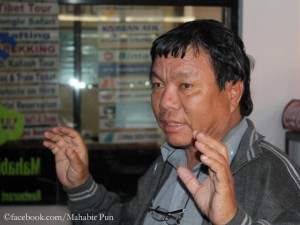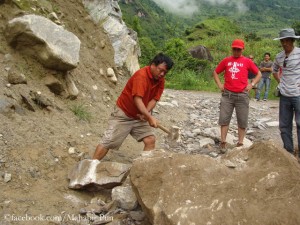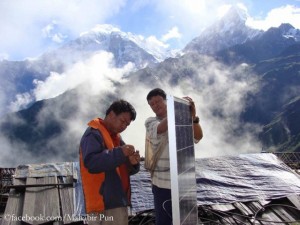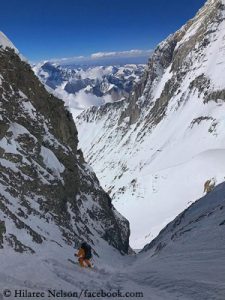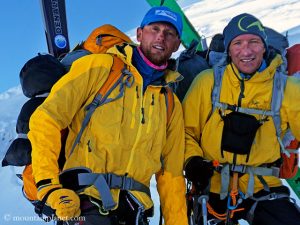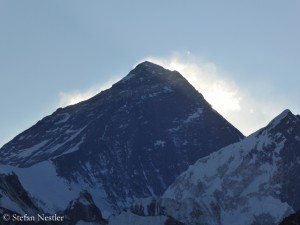New tourist tracking system for Nepal
This man has a vision. “I am thinking to write about how we can make Nepal a developed country in 30 years. It is not an impossible dream and I believe that it is doable”, Mahabir Pun writes on Facebook. The 59-year-old teacher was born in Nangi, a remote mountain village in the west of Nepal. After completing his studies in the USA Mahabir returned to his home country and founded a high school in Nangi. He brought WiFi and thus also the Internet to the mountains. For his achievements Mahabir Pun has received several awards, e.g. in 2007 the Ramon Magsaysay Award which is often considered to be Asia’s Nobel Prize.
Just now Mahabir has started a new project. In the region around the 8000er Annapurna a new tourist tracking system is being tested for six months. It was developed i.a. to locate and rescue single trekkers who have got in trouble. Nearly a dozen foreign tourists have gone missing from several hiking and trekking trails in Nepal over the past decade. I wrote to Mahabir to get some more details. He replied promptly.
Mahabir, did you develop this system by yourself?
“E-Networking Research & Development” is a NGO and I am the chairman. We developed this system with our Japanese partners from Japan International ICT (Information Communication Technology) Association. Hardware was developed in Japan and we worked together for its overall development.
Why didn`t you choose a GPS-based system?
I knew that there are GPS and GPRS (General Packet Radio Service) based system in the market. There are three constraints with those equipments. First, you have to charge the batteries frequently in a short period, and secondly the GPRS system works in the area where there is mobile signal. Third, they are expensive to buy and use. The small battery that “eTag” (the small device for the trekker) has needs to be changed only once in about three months. Also the relay stations run on small solar panels. Therefore the equipment is useful for remote areas where there is no GPRS signal, and it is less expensive than other equipment available in the market. It has very little operating cost too.
You are using signals transmitted like radio waves. Do you really need repeater relay stations (RRS) every two kilometers. That sounds extremely costly.
The relay station is a small stand alone device with solar panel and wireless devices which we put along the trails on poles or trees or lodges. It transmits the radio signals to other relay stations. They transmit information of the eTag carried by trekkers to the gateway which transmit the ID number of the trekker to the Internet. Right now RRS just has 10 mW transmit power and a reach of about 2 to 3 km That is why we need relay stations in about 2 or 3 km distance along the trekking trail. Later we can increase the transmit power of the equipment that can cover more areas. It is not too costly because there is almost no operating cost for it. It costs about US$ 400 for one device for now. The eTag costs about US$ 30.
There is a SOS button on the device. How near to a RSS must a trekker be so that his SOS signal is spotted?
The SOS button works if the trekker is within a distance of about 150 to 200 m from the RRS. It is because the eTag has just 1 mW transmit power for now.
What is the overall cost of the project? How do you finance it?
The overall cost of the project for now is US$ 30,000, which was supported by Asia Pacific Telecommunity for the pilot project. This is an organization with 38 member countries.
Do you plan to introduce this system in other trekking regions if it works, i.e. the Khumbu region?
After the pilot project is completed in about six months, we want the Ministry of Tourism of Nepal to implement the project for the security of the trekkers, guides and porters in other trekking trails of Nepal. For that I am asking the government to use part of the money they charge as trekking permit, park fee as TIM (Technology and Innovation Management) fee to the tourists. I want the service to be provided free of extra charge to the trekkers. I am lobbying with the government to provide the tracking system free of charge and issue eTags with the trekking permit. The government has lots of money to implement the system if it wishes to do so. Therefore I need support from people like you to put pressure to the government of Nepal for implementing the tracking system for the security of trekkers.
This system is intended for trekking tourists. In which way do the local people benefit from it?
The system can be distributed to the guides and porters. That way trekking companies can track their groups, guides and porters. In case of emergency, the porters or guides can also use it for help or use the system to send SOS signal by running close to the relay station. I don’t see any benefit of the system to local people for now. But may be in future we can find ways to make it useful for local people as well.
You dream of a WiFi-free Nepal. Are there no more pressing problems to be solved in Nepal which stills belong to the poorest countries of the world?
There are innumerable pressing problems in Nepal, which are much more challenging than making Nepal a free WiFi zone. WiFi is just a tool that helps to improve every system step by step if used properly. My goal is to use WiFi for helping to improve education and health programs in rural Nepal.
Right now I am trying to find ways to establish an innovation center in Nepal to use the innovative human resources for the development of Nepal. I am heavily involved in promoting community eco-tourism in Nepal and I have already started 5 days and 10 days new eco-trekking program fully run by the communities.



